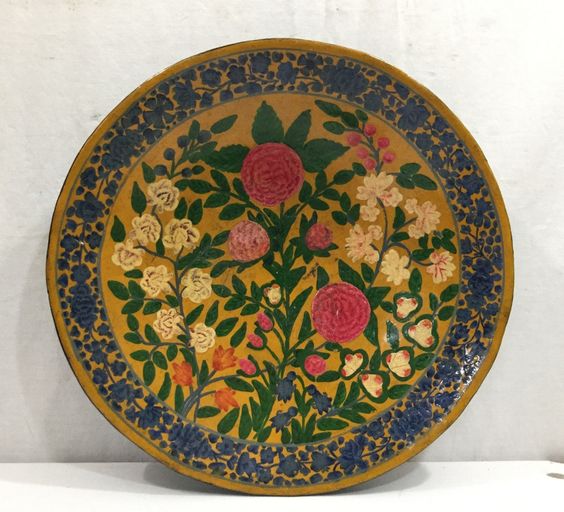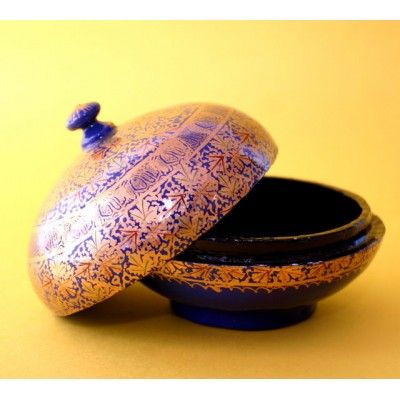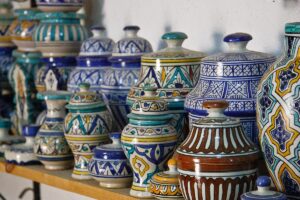Everything you need to know about India’s ever evolving art of
Paper Mache.
Paper Mache or Papier Mache is a craft of creating boxes, vases, trays and other small objects by using mashed up paper.
The objects are painted and decorated with excruciating details.
The handicraft is eco friendly as the leftover paper is used to create these objects.
The origin of the handicraft in India has some disputing tales.
However, the most famous one says that it was Mir Sayyid Ali Hamadani who brought the craft of Paper Mache with him.
The handicraft evolved in the Mughal era.
It was used to make small boxes at first.
Slowly, it evolved into more decorative art.
Even went on to take up space in the royal Mughal homes and courts.
The more recent evolution in the art has pulled its plug from the masses’ consumption.
You won’t see it in every other household. Cheaper alternatives have pushed it out of the markets of the masses.
Now, it has taken more to the luxury decor/collectables industry.
There are many states in India that have craftsmen who practice this art.
However, it is Kashmir where the roots of this handicraft lie.
Who did it first?
The term ‘Paper Mache’ is french for mashed/chewed up paper.
However, the French were not the first to discover the handicraft of making objects from mashed up paper.
It was the Chinese who first realised the advantage of Paper Mache objects.
They have been using this handicraft since 200 BC, since the era of the Han dynasty.
The Chinese invented paper which was expensive and rare at the time.
So they came up with a way to re-use it to make more expensive objects (not in comparison to paper).
The Paper Mache material turned out to be extremely light but also strong.
For a testimony of the material’s strength at that time, there is evidence that Chinese soldiers wore helmets that were made from Paper Mache.
Some other objects like mirror cases, snuff boxes and ceremonial masks were also made using this technique during that time.
The craft was said to have grown vastly in the East before it even set foot in the West.
Although France was not the first to use this technique, it became the source of its spread in Europe.
Through Europe, the craft further spread as a result of colonialism.
What’s special about India’s Papier Mache crafts?
There are different tales of how Papier Mache was introduced to India. However, in all these tales, one thing remains constant.
Kashmir is where the Indian roots of this handicraft technique lie.
Motifs refer to ‘a recurring idea or pattern’ in an artist’s work.
Kashmir has been a hub for various handicrafts. Craftsmen often use similar motifs/patterns in different crafts.
For example, designs that are usually seen on carpets and shawls are used as inspiration for designing Paper Mache items.
It is how you can distinguish Kashmir’s handcrafted products from the rest. Their unique yet recurring pattern.
You can easily recognise a handcrafted object if it is made in Kashmir.
The Kashmiri craftsmen often used these motifs to depict small tales.
You can still find pictures of soldiers in battlefields or a royal court on Paper Mache objects. Each object showcases a different story. It is how art helps in memorialising the political history of the land.
There are many popular motifs used for the designing of Paper Mache objects. Some of these are: Jamavar (a type of Kashmiri shawl), Gul-andar-gul (a complex design of a flower beneath another one), Gul-i-hazra (design of a thousand flowers), bagaldar chinar (a motif of a chinar leaf), etc.
These motifs are not the only reason for the differentiation of Kashmir’s Paper Mache. The Kashmiri craftsmen often also use paint made from actual gold to decorate some of the objects.
The differentiated technique has kept the craft alive even today.
How is it made?
There are two phases in the process of making objects from Papier Mache.
Sakhtasazi and Naqqashi.
The making of the basic structure and the painting.
Sakhtasazi
The Shakhtasaz are one set of artists who work on making the basic structure of the object.
For making the material: discarded paper, cloth, straw of rice plant and copper sulfate are mixed and made into a pulp.
This pulp is then put into wooden or brass moulds to get the required shape. When the material hardens, it is taken out of the moulds.
The process of smoothening of the material starts after it.
The material is then wrapped up in butter paper to prevent it from cracking when the paint is applied to it.
Finally, a coat of glue and chalk is applied to it.
Naqqashi
This is the stage of drawing and painting of the object.
It is interesting to see the artists individually painting each and every object from memory. You will never find two Kashmiri Papier Mache objects with the same pattern.
The brushes and paints used to paint Papier Mache objects are specially made. The brushes are made by coat, cat and ass hair threaded by silken threads at the end of feathers (quills).
For paints, they mostly use organically produced paints and paints made of gold in some special cases.
There are different motifs and other kinds of patterns that are used by the Kashmiri artists till date.
Common motif patterns include flower patterns, jungle patterns, soldiers, etc.
Each object is more vibrant and absolutely unique.
What are some different Papier Mache products?
Traditionally, this technique was used to make small containers during the Mughal era.
Though as time evolved, so did the types and kinds of Papier Mache objects.
With time, Papier Mache artefacts found homes in royal courts and castles.
From where their charm only spread further with a trickle-down effect.
Vases, bowls, wall plaques, mirror holders, frames for paintings/pictures, lamp vases, trays, all kinds of boxes, caskets, bangles, packaging for expensive gifts are some of the vibrant coloured variations of the products.
Other daily use items include steel trays and glasses, cookie boxes, etc.
Many furniture items are also made using this Paper Mache technique as they tend to be both functional and decorative.
One such example being bedstead legs made of paper mache.
The craftsmen make daily use objects into pieces of art. Which is why Papier Mache products fared well with the masses.
Crafters have also used this technique to make masks with a variation in the recipe of the pulp.
Small figurines and statues for some monasteries are other objects that have been made using Papier Mache.
From luxury collectables to daily use items, Papier Mache is a craft that has touched all sects of the economic pyramid.
No matter who you are, you can find something you’ll like.
That is the charm of this traditional craft.
Which other places produced Papier Mache products?
From the Middle and far East to Mexico and Europe, the craft of Papier Mache has made its way into many lands.
Although, very few have continued to produce through this technique in today’s capitalist age.
In 18th century Europe, Papier Mache products were used in a variety of ways by the classes and the masses.
Through colonialism, this craft was introduced to many other places such as Mexico and the Americas.
The English travelled and discovered new lands, introducing the native people to novel ways. Papier Mache craft was just one of them.
The craft of Papier Mache made room in the culture and traditions of Mexico and still sustains the livelihood of many craftsmen there.
It’s called Cartoneria in Spanish.
In India, there are many other parts of the country which produce different variations of products using this craft. However, Kashmir still remains the main hub.
Where can you find it?
In Kashmir, the craft of Papier Mache is mostly taught from one generation to another.
There are families which have been doing this for centuries.
However, people who are interested in the art can also learn.
It’s the karkhana or the workshop where the sale of Papier Mache products generally takes place.
In older times, this was a strategic decision. The workshop was placed near or inside the residence of the craftsman.
This helped them with having to travel little to less during winters.
With the added advantage of having the help of the female members of the household as well.
In today’s world, however, you can find these products mainly in:
- Tourist markets in their production states.
- Handicrafts businesses.
- Online platforms.
The handicraft of making objects through the technique of Paper Mache needs to be able to reach new markets.
It is a beautiful and sustainable art form which should be supported and appreciated.
At a time when mass produced products have become the only option, why not choose something that is unique?
Did we miss any important detail about Paper Mache?
If you know something we don’t, please mention it in the comments below so we can add it to the blog!
Did we miss something?
Let us know in the comments down below!












